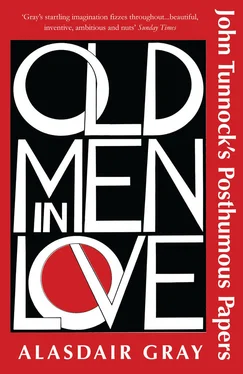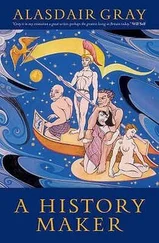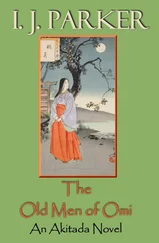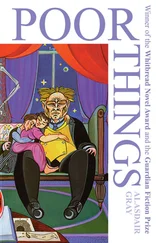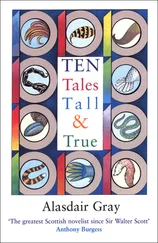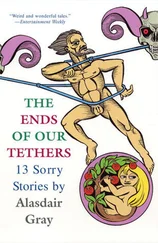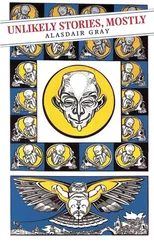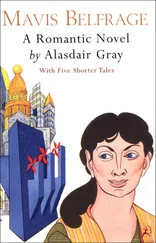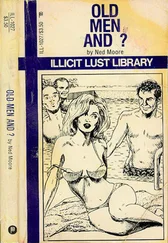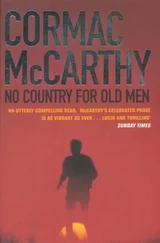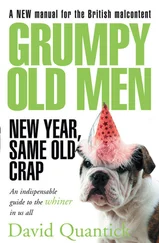In 1981 senior academics had just started lecturing on popular culture, so by ostentatiously blending fairy tale, science fiction and horror film elements with liftings from twentieth century authors most fashionable with academics, Gray boiled them into that 560 page postmodern stew, Lanark . The epilogue with my edited footnotes persuaded critics that the author was as smart as themselves. Favourably reviewed by the London press, Lanark was short-listed for the Booker prize, and two years after publication was on the curriculum of Scottish literature courses. Since then most studies of contemporary Scots literature suggest Lanark began a new Scottish Renaissance, without exactly dating the old one.
Between Lanark and Old Men in Love Gray has published eighteen books, none more than normal length. They consist of:
Two realistic novels involving sadomasochistic fantasies,
Four books of short stories (one shared with his friends Agnes Owens, James Kelman),
Two satirical novellas about young Scotsmen in the London media world,
Two science-fiction fantasies, one set in nineteenth-century Glasgow, one in a war-games future,
Three pamphlets urging Scots home rule, the last written with Professor Adam Tomkins,
Two histories of literature,
Two collections of verse,
One autobiographical pamphlet published by the Saltire Society,
One play script.
The novels and stories above are mostly prose versions of forgotten plays written between 1967 and 1977 for early television, radio and small stage companies. He admits this in epilogues usually headed Critic Fuel which, like the one in Lanark , defuse criticism by anticipating it. Since Lanark he has frequently given interviews suggesting his latest work of fiction will be the last since he has “no ideas for more”. These efforts to hold public attention have succeeded in Scotland, though most critics at home and abroad agree that his most pornographic novel, Something Leather , should be forgotten. Even so he has received a more than fair share of critical attention in two Festschrifts.
The Arts of Alasdair Gray (Edinburgh University Press, 1992), and Alasdair Gray: Critical Appreciations (British Library, 2002). The second is not a Scottish production, but like the first nearly every critic in it is Scottish and about half are friends of Gray, some of them close friends. Both books have a multitude of Gray’s illustrations, which proves Gray had access to the proofs, so must have overseen the texts. A cool, serious appraisal of Gray’s work cannot be found in them or, I believe, anywhere in Scotland, but they show why he has a following among bibliophiles — those who enjoy books for visual and typographical reasons quite separate from their literary value. Before appearing as a novelist at the age of forty-five Gray had not only failed as a dramatist, but as a commercial artist, portrait painter and mural painter. By bringing visual showmanship to book production he has contrived, with illustrations and jingling rhymes, to make the jackets, blurbs, boards, typography, layouts and even errata slips in his publications more entertaining than the main texts. Not since William Morris’s News from Nowhere and Rudyard Kipling’s Just So Stories has an author so controlled the appearance of his books, often varying them from one edition to the next, allowing collectors to always find something new. The two festschrifts are no doubt useful guides to these parasites on the tree of literature.
But outside academia and bibliomania Gray’s reputation is fading. Younger folk find more up-to-date working-class realism in Irvine Welsh, better science-fiction fantasy in Iain Banks. The minority interested in brazen Postmodern obscurantism find Gray’s Lanark far surpassed by James Kelman’s Translated Accounts (published 2001). Of all his works only Lanark has never been out of print, but here — and finally, claims Gray — we have over a hundred thousand words of his very last novel.
Henry James said H.G. Wells made novels by tipping his mind up like a cart and pouring out the contents. At first Old Men in Love seems to have been made in the same haphazard way, but some research in the National Library of Scotland shows it is stuffed with extracts from Gray’s earlier writings. The two big historical narratives are from television plays commissioned by Granada in the 1970s. The Greek one was broadcast in a series called For Conscience’s Sake , with Christopher Logue in the part of Socrates. It extensively plagiarised Plato’s Symposium and passages in Plutarch . For a Queen Victoria’s Scandals series Gray then plagiarised Henry James Prince’s published diaries and Hepworth Dixon’s Spiritual Wives . He refused to let his name be attached to the broadcast because a producer or director had changed the script in ways he disliked, after which British television had no use for Alasdair Gray. The archive has three typed dialogues for a TV play about Filippo Lippi that was never commissioned, so Old Men in Love has only three Florentine chapters. These rags of forgotten historical plays fill nineteen chapters.
The rest are stuffed with a great deal of half-baked popular science tipped in from Gray’s 2000 anthology The Book of Prefaces , also political diatribes from pamphlets published before three general elections that were victories for New Labour. These diatribes were and are protests against the dismantling of peaceful British industries and the welfare state, a process that has made Gray and many other professional people richer. The description of an anti-war march was written for The Herald in February 2003, then added inappropriately to The Ends of Our Tethers , a collection of tales printed in 2004. (It may be no coincidence that Will Self describes a similar protest march in The Book of Dave , published 2006.) Like most Scotsmen Gray thinks himself an authority on Burns, so we find an essay about Burns mostly published in volume 30 of the 1998 Studies in Scottish Literature , edited by Professor Ross Roy. The most shameless padding is in chapter 17 which reprints verbatim a section from chapter 8. The marginal note signposting this obviously invites readers to think it a charmingly eccentric Shandyan device, but Laurence Sterne’s typographical stunts in Tristam Shandy are never more than a page long. This repetition is beyond a joke.
Three literary ploys try to unify the whole rag-bag. The Introduction uses the text-as-found-manuscript invented by Scott for his Tales of My Landlord novels and afterwards plagiarised by Hogg, Pushkin, Kierkegaard, Dostoevsky and Gray in two earlier novels. From Scott also comes the printing of portentous quotations as epigraphs, some genuine and some pseudonymous, a device run to death by Pushkin, Poe, George Eliot and Rudyard Kipling. All but the introduction are cynically sandwiched between references to the 2001 Trade Center atrocity and May 2007 Scottish election in order to give the whole thing spurious contemporary relevance. When all the above is discounted we are left with the dreary tale of a failed writer and dirty old man, who comes to a well-deserved end through an affair with a drug-dealing procuress. This story is neither tragic nor funny.
The best criticism of Gray is to quote his own and believe it. In an 1990s epilogue to Something Leather he says all his stories were about men who found life a task they never doubted until an unexpected collision opened their eyes and changed their habits. The collision was usually with a woman, and the transformation often ended in death . He adds that knowing how his talent works shows it is defunct because imagination will not employ whom it cannot surprise . After that Gray published nine more fictions with this hackneyed plot, Old Men in Love being the last. The four old men are all versions of Gray in fancy dress, with the Socratic collision homosexual, and though this novel may indeed be his last I cannot simply dismiss it (as Allan Massie dismissed Gray’s 2004 The Ends of Our Tethers ) by calling it a collection of scraps from a tired writer’s bottom drawer. Neither the blurb which Gray lured Will Self into writing nor the egoism of the text will repel empty-headed fans of these egregious authors. Many may fall under the influence of its sinister propaganda for Scottish Nationalism and Socialism.
Читать дальше
